The requirements for water supply at the dacha are not lower than in urban apartments, but higher: it is necessary to ensure supply not only to taps and household appliances, but also for irrigation. Therefore, the pump performance should be high, and the debit of the well or borehole – good and stable. We have to solve another problem: in rural areas, electricity is often cut off, so it is desirable to have a reserve of water or a backup method of its “extraction”. For the owners of wells everything is not difficult: for urgent needs you can get a bucket, but from the well just do not get it. You have to come up with backup schemes.
Contents of the article
Organization of water supply at the dacha
Organize the supply of water in the dacha can only use a pump, but it can be supplied in two ways: from a storage tank or from a hydroaccumulator.
When using the scheme with a storage tank, you have a stock of water equal to the volume of the tank, but the pressure in the system is low. It is created by the height difference: the tank is installed at a height – on the attic of the dacha or the roof of the farm building. The main condition – its bottom should be above any point of water intake. Then there will be water in the taps.
The second method – with a hydroaccumulator is more convenient because the system creates and automatically maintains pressure. If the hydroaccumulator supplemented with a pump and automation (pressure switch) the whole assembly is called a pumping station. The trick here lies in the hydroaccumulator. It is a cylindrical tank, divided into two parts by an elastic membrane. In one part, gas is pumped under low pressure, and water is pumped into the second part. As it arrives, the water increasingly squeezes the gas, which creates pressure in the system (about 2 Atm).
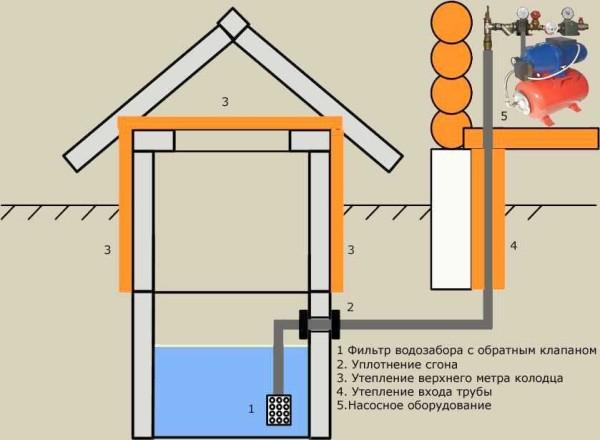
When the faucet is opened (household appliances are turned on or irrigation begins), water is supplied from the hydroaccumulator. In it, the pressure gradually decreases. Its value is controlled by special relays. As soon as the lower threshold is reached, the pump is switched on, restoring the set pressure value. The highest threshold is controlled by a second sensor, which disconnects the pump.
Such a system of dacha water supply can be realized in both winter and summer versions. The difference is in where to install the equipment and how deep to bury the pipes.
What pipes to choose for plumbing in the dacha
A decade and a half ago, and there were no questions: there was no alternative to steel pipes. Today, however, for dacha plumbing metal is almost never used: expensive, need welding for installation, and rust modern pipes quickly. There is a much more practical alternative – plastic pipes. They are for dacha water supply – the best solution: do not rust, some are not afraid of frost. But plastic – it is different, as well as products made of it.
HDPE pipes
Most often for plumbing in the dacha use HDPE pipes – low-pressure polyethylene. They are attractive because they can be assembled without any additional devices. Fittings for assembling HDPE water pipes have threads and are simply screwed in by hand.
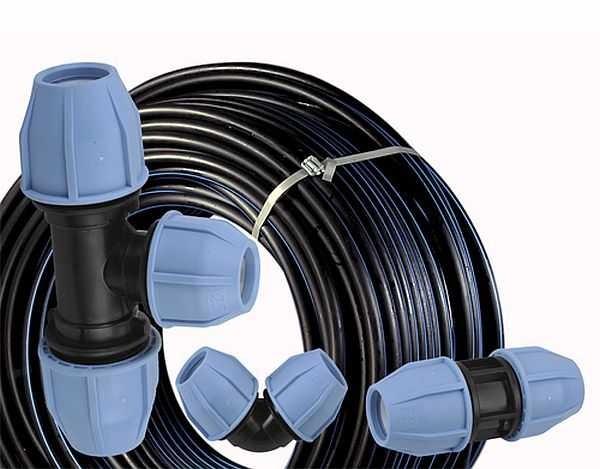
What is so good polyethylene HDPE pipes that they almost displaced metal ones? In addition to convenient installation, there are a number of advantages:
- If the rules of operation are observed, the service life is 50 years. So far this figure has not been verified, but it is impressive.
- They do not rot, do not rust, resistant to chemical environments.
- They can be operated at temperatures down to -60°C.
- When water freezes in them, they do not burst – they stretch, then after thawing they take their former size.
- Their inner surface is perfectly smooth. This is important for water pipes for two reasons: less pressure loss during transportation and no deposits accumulate on the walls, they are simply swept away by the flow.
- With their help, it is very easy to make plumbing in the countryside with your own hands, as well as to make changes later.
- Use HDPE pipes can be used for the device of summer and winter plumbing.
- Convenient ways of assembly: by welding or on compression (threaded) fittings.
There are disadvantages, but they are few:
- poorly tolerate heating (except for pipes made of cross-linked polyethylene) because they are used only for transportation of cold media;
- if compared to metal, have lower strength – you can not walk on them.
HDPE pipes can be welded with a special apparatus, and can be connected with compression fittings. For dacha plumbing, pieces of pipe, tees, adapters are connected using threaded connections. Although it seems that such a connection is unreliable, it can withstand much more than 2-4 Atm, which you can maximally create. See the video for the results of tests on threaded fittings. At the same time learn their design and installation principle.
HDPE pipes with blue lines on them are suitable for plumbing. They are intended for cold water. If the lines are yellow, they cannot be used for water supply – they are designed for gas. They contain special additives that make water unusable.
There are several gradations by working pressure:
- L – light, withstand up to 2.5 atm;
- SL – medium-light – up to 4 atm;
- C – medium – up to 8 atm;
- T – heavy from 10 and above.
For the installation of outdoor (street) water supply at the cottage use HDPE pipes class C and SL, with diameters of 32 mm, 40 mm and 50 mm. When choosing, you still need to determine the density.
There are three more brands of polyethylene: PE 63, 80, 100. These numbers mean density. The more dense the material, the stronger the products, but also the higher the price. For example, one running meter of 32 mm pipe from PE 80 costs from 4$ (and more depending on the wall thickness). The same diameter, but from PE 100 already from $ 7 per linear meter.
Is it necessary to have a high density when installing a water supply system on the chacha? Probably, yes. Due to higher density, the walls of the pipes are thinner, which reduces their weight. If the water at the dacha is taken from a well or well, the weight can be an important factor – there will be fewer problems with fixing the pipe lowered down.
PVC pipes
For plumbing in the dacha use more pipes from PVC – polyvinyl chloride. They are cheaper than HDPE, connected with the help of cold welding – on the glue. The seam is reliable – it can withstand pressure up to 12-16 atm, the service life is the same: 50 years.
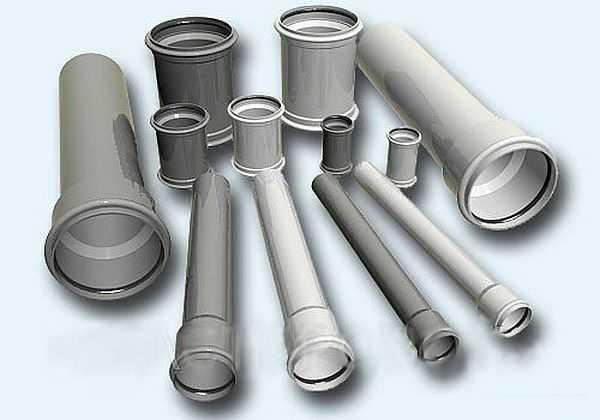
Characteristics are slightly worse than those of low-pressure polyethylene:
- Temperature mode of use from -15°C to +45°C.
- Does not like freezing – elasticity decreases, the material becomes more brittle.
- Average sensitivity to the effects of ultraviolet light.
The other advantages of plastic pipes are inherent in PVC in full:
- Ease of installation, the possibility of bending.
- Smoothness of the inner surface.
- Resistance to oxidation (do not rust) and chemical media.
- Malogoflammable.
The disadvantages of PVC dacha plastic water pipe are as follows:
- Upper temperature limit of +45°C, short-term possible up to +65°C.
- It is difficult to dispose of, because when decomposing it emits volatile chlorides, harmful to health and the environment.
- If the surface of the pipe is scratched, its durability is significantly reduced. Therefore, PVC pipes for the open laying of water pipes in the cottage is undesirable to use. In case of underground laying, a protective casing or laying in the sewer is mandatory.
Since scratches and cracks greatly reduce reliability, threaded connections are impossible. When joining metal pipes or equipment inlets, this is a big problem. And if the piping of the site is not difficult, then tying the equipment – a serious task. This disadvantage limits the use of this material for outdoor plumbing, because PVC is more often used for internal wiring, where the risks of scratches are minimal. Even more often they are used for laying sewerage.
How to connect PVC pipes see in the video. The connection is really reliable. This conclusion is based on personal experience: a cold water comb was assembled in the apartment. It stood for about 10 years without any problems, until it was necessary to redo all the wiring because of redevelopment.
Polypropylene (PPP)
Another material that can be used when installing plumbing in the dacha with your own hands – polypropylene pipes. They also belong to the category of plastics. There are for cold (with blue stripes) and hot plumbing, as well as for heating (with red stripes). They are connected by soldering and couplings – there are special soldering irons, which are used to heat up the plastic on the two parts, then they are connected. After a couple of minutes, the connection becomes monolithic. Soldering iron does not even have to buy (costs about 2-5 thousand rubles.) – it is given for rent in the same stores where they sell pipes and fittings for polypropylene plumbing.
The disadvantage of polypropylene pipes is essentially one – expensive fittings. For example, a linear meter of pipe for cold water supply 32 mm in diameter (wall thickness of 3 mm) costs about $ 2, a coupling to connect two sections of the same diameter 1.2$. Since the PPP pipe does not bend, everything is assembled using couplings, angles, etc. As a result, the water supply will not be very cheap, but reliable. After all, this material is used to assemble not only household water pipelines, but also industrial routes.
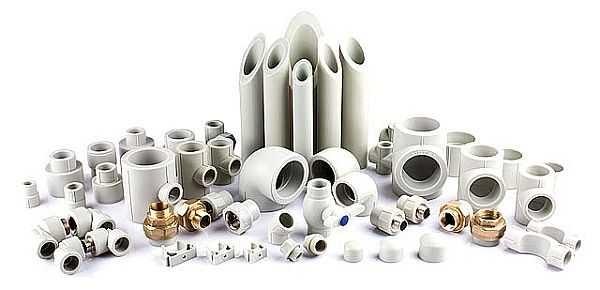
About drip irrigation systems and how to make them yourself can be read in this article.
How to assemble a water pipe
Assembling plumbing in the dacha with your own hands you need to determine in which parts of the site you need to divide. The fact that water should be supplied to the house is self-explanatory. But in addition to the distribution of the water pipe in the house, you need to irrigate the pipes in key places of the site, put on them taps. To them, if necessary, connect the hose and, shifting it from place to place or installing a sprinkler, watering the nearby beds.
How to conduct water into the house, read here, and how the plumbing should be made on the dacha plot with your own hands we will talk further. It is most convenient to draw a plan to scale. If you already have beds, you can easily determine where you need to deliver water. It is better to make a few water points: long hoses are inconvenient and hard to carry, and having the opportunity to connect several simultaneously, you will cope with watering faster.
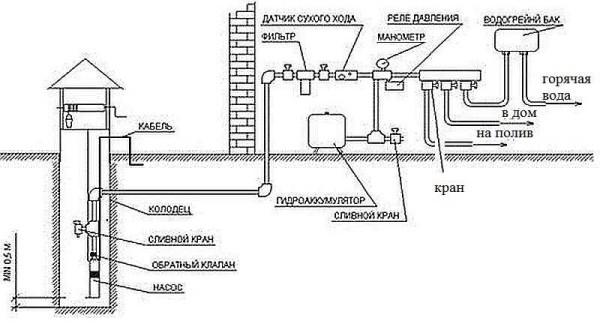
When drawing up the scheme, do not forget about the need to install taps on the main line: cut after the outlet still in the house, and then, on the plot, before the first branch. It is desirable to install taps further on the main line: this way it will be possible to disconnect the emergency section in case of problems.
Even if the equipment will be equipped with a summer water supply, you will need to drain the water from the pipes, so that when it freezes, it does not rupture them. To do this, you need a drain cock at the lowest point. That’s when you can close the faucet in the house, and drain all the water, securing the plumbing from winter damage. This does not have to be done if the pipes dacha plumbing is mounted from polyethylene pipes (HDPE).
After drawing the scheme, count the meterage of pipes, draw and count what fittings are needed – tees, angles, taps, couplings, couplings, adapters, etc.
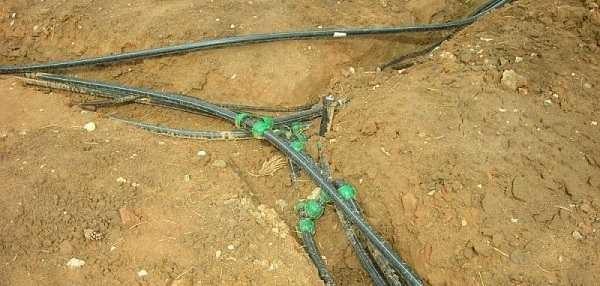
Then you need to determine the mode of use. There are two options: summer and winter plumbing. They differ in the depth at which the pipes are buried. If you have an all-season dacha, then in the dacha itself to lay insulated water pipes or bury it below the depth of frost. For irrigation pipes on the dacha is more rational to use the summer version of the water supply system. Winter you will need only if you will be equipped with a greenhouse. Then the section of the water pipe to the greenhouse will need to be equipped in a serious way: dig a good ditch and lay insulated pipes.
Summer plumbing in the summer cottage
Depending on what pipes you will use, they can be left up, and you can lay them in shallow ditches. Installation of the dacha water pipeline underground will take more time, but it is more reliable.
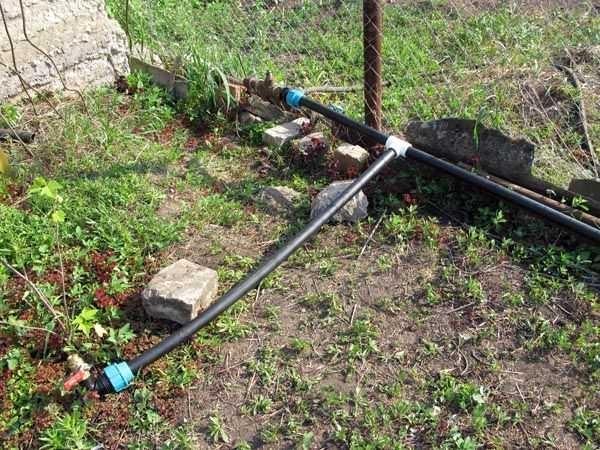
Having determined whether you need trenches or not, and having dug them, if you choose the underground option, the pipes are stretched and spread out on the site. This once again checks the correctness of the calculations made. Then you assemble the system. The final stage – testing – turn on the pump and check the quality of the joints.
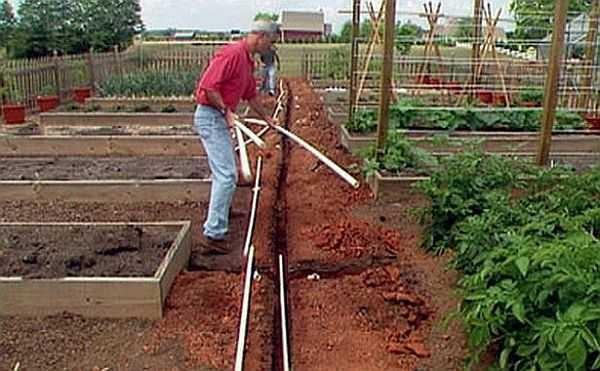
Winter water supply differs from the summer one in that the areas that will be used in the cold season must be guaranteed to be protected from freezing. They can be laid in trenches below the frost depth, and/or insulated, and/or heated with heating cables.
You can read about the organization of auto irrigation here.
Autonomous water supply at the dacha
Since in rural areas the lights are often cut off, and any pump can only work if there is electricity, it would be good to have a reserve supply of water in case of disconnection. This can be a tank installed in the attic or on a separate site. It can be pumped into it with a submersible pump from a well, well, river. And the pumping station will “pull” water already from this tank.
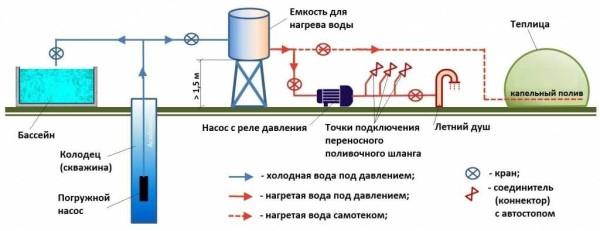
Water supply in the dacha from the tank is convenient in that it can be collected and rainwater, but you need a good system of filters: first coarse cleaning, then a few pieces of fine. And be sure to put a filter and a check valve at the inlet of the suction pipe from the pumping station. The filter – for insurance – the equipment is demanding on water quality, and the valve, so that when you turn off the pump water is not dumped back.
The presence of a tank in the plumbing system of the dacha is good for plants: in summer, if it is installed outside, the water will be heated. And it is known that plants watered with warm water, grow more actively and fruit better.
If desired, you can organize drip irrigation – from the pipes to collect the main line, in the right places to insert tees to which to connect hoses for drip irrigation.
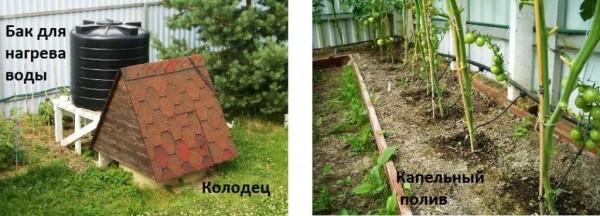
Here is how it looks schematically. The tank is raised to a height of at least 1 meter. Pump water into it from a well, well, river. Its level is controlled by a float mechanism (such as those that stand in the drain tanks). From the lower part of the tank comes the distribution to the beds. First comes a solid water pipe, and from the tee departed drip – with holes.
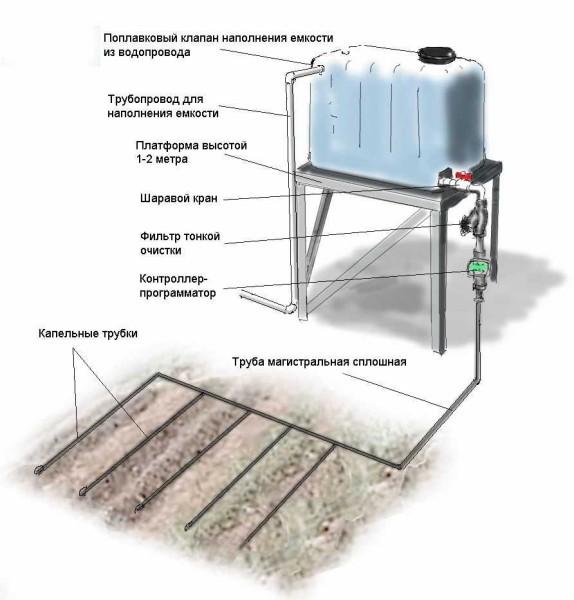

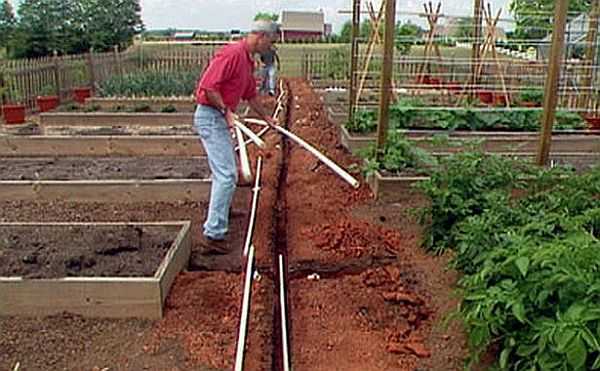
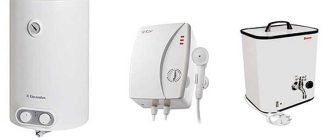
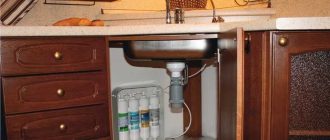

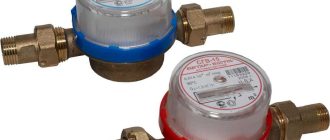
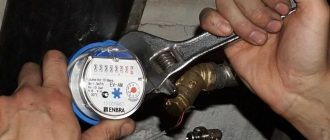
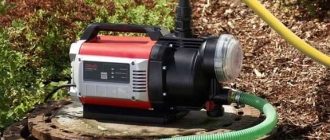
I totally get the struggle! When I set up my dacha’s water pipeline, I went with PVC pipes – super easy to handle! Following a simple layout made the whole process smooth. Gotta say, it feels great to have running water out there now. Major win!